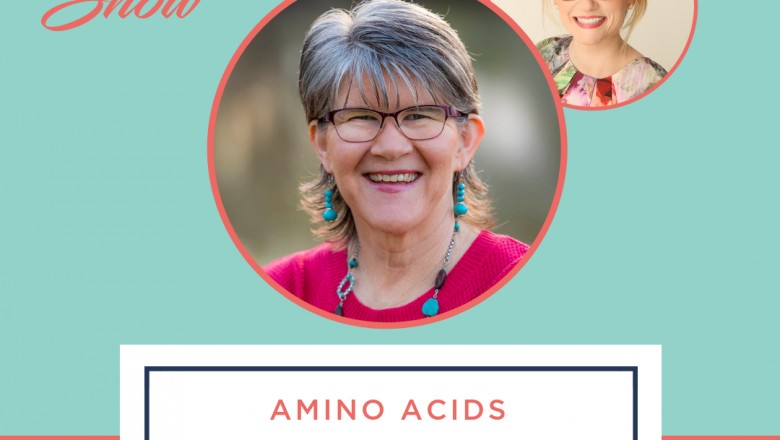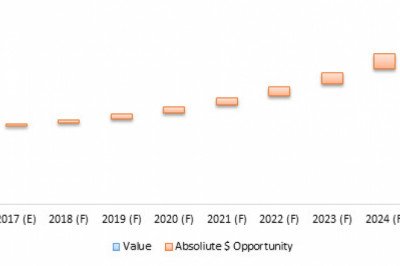views

Amino Acids Can Help To Relieve Anxiety In Children
Better Behavior, Naturally
My guest this week is Trudy Scott, a certified nutritionist on a mission to educate and empower parents and children who suffer from anxiety. She is known for her expertise in the use of targeted individual amino acids, the social anxiety condition pyroluria and the harmful effects of benzodiazepines. Trudy is the author of The Antianxiety Food Solution: How the Foods You Eat Can Help You Calm Your Anxious Mind, Improve Your Mood and End Cravings.
In this episode, Trudy and I discuss the incredible impact that targeted amino acids can have on both children and adults with anxiety when approached with the right guidance. Trudy shares a few case studies demonstrating the use of amino acids such as Tryptophan, GABA, DPA and more. Connect with Trudy online via her blog, Facebook, and Twitter.
Where does anxiety come from?
What Are Amino Acids?
Amino Acid Supplements
Assessing Anxiety Caused by Low Serotonin
Amino Acid In-Office Trial
Anxiety Caused by GABA
In-Home Amino Acid Trial
Other amino acids to consider
Where to learn more?
Episode Intro … 00:00:30
Trudy’s Anxiety Story … 00:03:06
What Are Amino Acids … 00:10:10
Anxiety Caused By Low Serotonin … 00:12:15
Amino Acid In-Office Trial … 00:20:31
Anxiety Caused By GABA … 00:23:55
At Home Amino Acid Trial … 00:25:20
Episode Wrap Up … 00:32:55
Dr. Nicole Beurkens:
Hi Everyone and welcome to the show — I am Dr. Nicole Beurkens and today, I am excited to have Trudy Scott as my guest! Trudy is a nutritionist, and she and I have been colleagues and friends for several years now and I am really excited for her to be here to talk about her work in the realm of anxiety. So many of your kids with behavior challenges and other kinds of issues — anxiety as at the root of that and so I thought it would be great to have her come out and talk about her experience with anxiety, the specific, really practical ways she approaches that. And I know she is going to have lots of different information that you probably haven’t heard before that will be really helpful.
Trudy is a Food Mood expert — a certified nutritionist who is on a mission to educate and empower anxious women, so they can find nutritional solutions for their anxiety and stress. She’s known for her expertise in the use of targeted individual amino-acids. The social anxiety conditioned Pyroluria and the harmful effects of Benzodiazepines. Trudy is the author of the Anti-Anxiety Food Solution — How the foods you eat can help you calm your anxious mind, improve your mood and end cravings. And she’s the host of The Anxiety Summit, now in its 4th season. Trudy is passionate about sharing these powerful nutritional tools because she has experienced the results firsthand by the complete resolution of her anxiety and panic attacks. Trudy, welcome!
Trudy Scott:
Thanks so much for having me Dr. Nicole and it’s really fun to be here. You interviewed me when I was first starting out, and then I interviewed you on The Anxiety Summit, so it’s really great to be able to share expertise like this. I’m excited to be here.
Dr. Nicole:
It is and I am so excited that you agreed to come on because I think so many parents struggle with anxiety for their children and even for themselves and haven’t been exposed to a lot of the options that are out there for addressing anxiety. Typically, if your child is anxious and you are experiencing anxiety, you talk to your healthcare provider about that, they’re like, ‘Well — Here’s a prescription.” Or “Go get some counseling.” And while certainly, those things can sometimes be helpful, what most people don’t understand that there’s this whole array of specific targeted nutrition kinds of solutions that could be helpful, so I am really excited to dive into that and I would love for you to share your story about this because you have a really personal connection to the topic of anxiety and how you got into this field in the first place. So can you share a bit with people about that?
Trudy:
Yes, and I am really passionate about it because I experienced it firsthand. And I was working in corporate America and working really long hours, stressed out, burned out, not getting enough sleep — and I started to get increasingly anxious. And I would just remember waking in the early hours with this feeling of doom like something is going to happen. And I had no reason to be feeling like that. I became more socially anxious, I didn’t even enjoy family gatherings, and then I had some panic attacks and I remember that first panic attack — I had no idea what it was. And I just thought I was going to die. I couldn’t breathe, I felt clammy, I felt shaky, I felt nauseous. I just felt terrible and I had no idea what it was. And I had a few more after that. I remember getting on the internet — well, I passed out because I was so exhausted, my husband spent the whole night on the internet trying to figure out what that was and what we could do.
And because of my upbringing in South Africa, I knew that there was something biochemical going on, I didn’t quite know what, but I had grown up eating real whole food and not going to the doctor a lot. And I started to look for nutritional solutions or natural solutions. I first went to a nurse practitioner and then I went with a naturopath and I started to see that I had this perfect storm of factors that were actually biochemical. There was no trauma, there was no psychological impact. It was just biochemical and it was — low Zinc, it was low GABA, it was low serotonin, it was gluten issues, it was adrenal issues, it was a mouth full of amalgam that was poisoning me with mercury, I switched to a vegetarian diet, I had all of these things that I call this perfect storm. I was going through perimenopause and my hormones were changing and that was having a huge impact. I discovered I had low progesterone, I had estrogen dominance, I had all of these factors, but long story short — once I addressed those underlying causes, my anxiety and panic attacks went away.
But as you can hear, with mercury toxicity, and with gluten sensitivity, and with leaky gut and the resulting nutritional deficiency — those take a long time to address. I was fortunate in discovering the amino acids and we are going to talk about those today and using GABA (Gamma-Aminobutyric Acid). GABA was my life saver. Using an amino acid like GABA, for example, gave me relief right away and I was able to deal with all these underlying factors which took a long time to address. At the time, I didn’t have this 9-step approach that I use with my clients. I was kind of figuring it out as I was going, so it took a little bit longer, but now I use this approach with my clients.
And I work primarily with women and someone who is listening to this for their child might think, “Well, how could this help my child?” But a lot of the women that I work with have anxiety and their children may also have anxiety. And if it’s a biochemical reason, the underlying cause might be similar. As a mom, you may have issues with gluten and your child may have issues with gluten which can trigger anxiety and panic attacks. If you’ve got low GABA, your child might have low GABA, so I work with the moms using these amino acids as supplements and some of these other underlying factors that we need to address and then they’ll see the effects, and then through them, I work with their kids. I don’t have experience working with kids, I don’t have the extensive experience that you have, but a lot of the time the same underlying causes will run through the family. You may have a grandmother, you may have a mother, you may have children and brothers and sisters with a similar effect.
And long story short, with the amino acids — with making all those nutritional changes, I no longer have anxiety, I no longer have panic attacks and when I go to an event, I am considered a social butterfly. I like to mingle and I feel very comfortable in social settings. So there are solutions and sometimes it can take a little bit longer to get to those solutions, but finding the root cause is so powerful. Long story short, I went back to school to become a nutritionist and now this is my mission: To help those who may be having anxiety, panic attacks and social anxiety.
Dr. Nicole:
Yeah — it’s so great and I think that so many of us have had a personal connection to the kinds of things that we are dealing with, right? Whether it’s for ourselves personally, and that spurred us to go back and get more education and do something or experiences with our kids. And I think it’s really helpful for people to understand the personal connection that we have. We know what these things feel like, right? We know what it’s like, like in your case, to struggle with anxiety and how that affected you, so I think that personal connection is so important. And I really appreciate what you said about the fact that there can be a lot of underlying conditions, whether it’s with anxiety, or really any of the things I talk about with families — whether it’s kids who have autism or ADHD or they just have a diagnosis of anxiety disorder, depression, things like that. Often there are several underlying issues that need to be addressed, but what I think is so cool about the amino acids and those targeted aminos: Is as you said, you can get relief pretty quickly and I think particularly in the case of anxiety, which I see across the board with kids with behavioral challenges. Whether they are diagnosed with things or not, anxiety is such a driving force for a lot of the challenges that kids experience. I think that the fact that these can work quickly is really helpful. And as you said, it helps to take the edge off, it helps to reduce the symptoms so then we can more effectively address all of the underlying things. Because often, I’ll have parents say, “Oh, you want me to change the diet and do all these things, I just feel so overwhelmed, my kid is having so many issues, I don’t know how we’re going to do any of that.” And then when you can use things like targeted aminos to help take the edge off the symptoms for the parent and the child, it makes all of that other stuff more doable, I think.
Trudy:
Absolutely. Because if you say… making those dietary changes are hard. There’s the addictive component, there’s a social aspect, and if you can make those changes, especially with children, so there’s not this fat adversity and then with moms it’s willpower and white-knuckling it and I’m getting through this — it just makes it so much easier, and I just wanted to mention, you know, you said using aminos while you’re addressing the underlying biochemistry imbalances, but the neurotransmitter or brain chemical imbalances are one of the deficiencies that we are addressing. Because a lot of people will say, well isn’t this like a band-aid? Isn’t this like taking medication? It’s just we’re using it short term while we are addressing the real cause. But some of those real causes that lack gluten sensitivity can lead to low serotonin or having poor digestion. And low zinc status can contribute to low GABA levels. So we are fixing something in the short term, but we are also addressing one of the root causes. So I think that is an important clarification for people to know that.
Dr. Nicole:
Yeah that’s a great point. For people who aren’t aware, we’re throwing around this term, ‘amino acids’, can you just quickly kind of give people some context for understanding what amino acids are? What are we talking about when we say amino acids?
Trudy:
So when we’re talking about GABA and tryptophan as amino acids, they are supplements that are taken in supplement form, and they are precursors for making some of our brain chemicals — for example, we’ll use tryptophan to help us make serotonin, which is a calming amino-acid, it also helps with low mood. And then we’ll use GABA as an amino acid to help with GABA, which also happens to be a neurotransmitter which is also calming. They are the building blocks of proteins and when we consume a piece of crossbred red meat or a piece of fish or some healthy eggs. When we break those down, we break them down into amino acids. So that hopefully gives people an idea of what is amino acids. When we’ve got issues like malabsorption issues or nutritional deficiencies, we don’t have enough of the raw materials to make our brain chemicals or our neurotransmitters. So using these as supplements helps top up our levels while we are addressing these other factors.
Dr. Nicole:
Yeah I think that’s helpful because people have often heard about things like nutrients, like certain vitamins, minerals, an amino acids are maybe a term that they’ve heard but are not really sure what they are, so I think that’s some helpful context. So you talked a bit already about how when it comes to kids, you often starts with moms because your population tends to be adult women, so you kind of start with moms and then go to the kids. I’d like to delve into some case studies and just talk through some of the specific targeted aminos that you use, certain types of cases that you use them for, I like to give people an idea of how these can be used, because the way that you do this is so practical and can help with so many different things. So why don’t we start with talking about anxiety that’s caused by low serotonin? So you mentioned serotonin as being an issue, so let’s start talking about that. How are some ways that you specifically address that? Maybe let’s talk through a case.
Trudy:
So first, you’ve got to start thinking about — what are the symptoms that go with low serotonin? And using a questionnaire is the way that I have been taught and found to be the most effective way to assess if someone may be low on serotonin. And we don’t know until someone does the questionnaire and we look at the symptoms. And then we do a trial of an amino acid, of that respective amino acid to see if that’s what they actually have a deficiency in, because the amino acids are only going to work if you need them. If that is what is the deficiency and that is what’s causing the mood issues. So looking at the low serotonin symptoms, we look for anxiety where there may be incessant worry about things.
Reprocessing, rethinking things, like a child may come home and constantly talk about something going on in school that they’re really, really worried about. Insomnia is a big thing, so not being able to go to sleep or not being able to stay asleep or even waking in the early hours, cravings are associated with all the brain chemical deficiencies, but with low serotonin, it’s the afternoon and evening cravings. So you may be find during the day, but come in late afternoon, come in the evening they’re really wanting sugary foods.
Negative self talk, lack of confidence, just fearful or phobias. So any kind of thing where there is worry in the head, sort of ruminating thoughts and fears, these are all low serotonin factors. Anger issues are also often very common with low serotonin.
And an example I am going to give you is a little girl that I worked with, she was adopted, she was diagnosed with reactive attachment disorder and had explosive anger issues. And she also had insomnia, so she was not sleeping well at all. So she was very fatigued in the day, had really bad anxiety about going to school and loved colored candies, she just loved sugary candies and she was a big bread eater. And the mom came in, this is a different instance, where there was a friend who referred the mom and they didn’t have much money to spend, so I really had to figure out a few things with the least amount of cost that would have the biggest benefit. And I had some blood work from her doctor, she was anemic.
So we addressed that with iron supplements and getting her eating quality crossbred red meat again and we figured out that gluten was an issue and she eventually went gluten-free. And we know that gluten can cause a number of behavioral disorders, one of them being low serotonin because of malabsorption issues and damage to the gut. But what we found out, was that serotonin was a big factor for her. And the way we found out is that I had asked the mom some questions. And it was very obvious with the anger, the insomnia, the anxiety and the sugary cravings that it was likely to be low serotonin as a factor, so we wanted to do a trial of one of the amino acids. So in the office, I was talking to her about the fact that she loved candies and she loved bread, and I said — how would you feel about giving it up, and she was fuming with me. And she was in a swivel chair and she turned her back to me and she didn’t want to talk about it.
So, I got an idea from her mom on how serious her symptoms were, and I said to her — she still had her back to me, “How about trying this amino acid, it’s called Tryptophan, it’s a hundred milligrams and it’s chewable and it doesn’t taste pretty bad. How about trying it and seeing, and then we’ll talk a little bit later. Don’t worry about what I said earlier.” So I gave her 100mg of chewable Tryptophan and this is a nice one to use with kids because it’s a nice small dose. You want to start low with kids. She happened to be 11 years old, it was a nice starting dose. She chewed this Tryptophan and within 5 minutes, she turned around, smiled at me and said, “I think I can do it, I’m ready to do it.” And it was amazing, just these 3 interventions completely turned this little girl around.
She went gluten-free, we got her iron levels up and she started to use Tryptophan and once we’d figured out that 100mg during the trial was going to have an impact, we actually got her onto 500mg, we moved up pretty quickly over the course of the next few weeks to 500mg, twice a day — that was mid-afternoon and evening, and this little girl was transformed. No more anger issues. And her anger issues had been so bad, that her mom had to physically sort of power over her to protect her from hurting herself and hurting others. That’s how bad her explosive anger issues were. So we got resolution of the anger, the insomnia, the anxiety, and it helped with the cravings.
Now, a little bit after I started working with her, she went off a party and she had some cookies and she had exposure to gluten and then I could see how strong this exposure to gluten correlated with her symptoms. And this is pretty common to see that kind of result, the important thing is figure out if it is low serotonin. And it could also be low GABA and it could be the gluten, it could be multiple other factors, but figure out those root causes, do the trial and then see how the child responds.
Dr. Nicole:
Yeah, and I can say in my experience too, when you do the trial in the office, you can see some kind of shift pretty quickly. Sometimes it’s not as dramatic as what that little girl experienced, but in general, I find that if you observe carefully the parents, and I observe carefully, you can see even something as simple as an affect change in how their face looks or something different about their communication, you can see something shift in a positive direction that lets you know — okay, this amino acid seems to have some sort of beneficial impact on them.
And if not, then that’s not the right solution, then we look to something else, but I love how these are easy to try quickly and to assess if there is any kind of response. So tryptophan is one option that you look to for the low serotonin type of anxiety. Can you give some example, what are some of the other aminos that may be connected to low serotonin for people?
Trudy:
5-HTP is another one. I tend to start with Tryptophan just because I have had some good results with it and because it’s closer to being a food, and there is some research — one study that shows that 5-HTP can raise cortisol levels and one of the other possible root causes of anxiety could be high cortisol, so we just have got to be a little bit careful with that, and then with children, they sometimes can’t really communicate how it’s affecting them.
With adults, too much 5-HTP can cause a wired kind of feeling, where someone could feel a little bit revved up and although we can observe children, sometimes it’s a little bit hard for them to give us that feedback, but that being said, if I worked with a mom and she’ done well with 5-HTP, I have found that the 5-HTP has worked well with the child. And that may not be always the case because there can be many factors for the mom, it could be hormonal factors or something else that she has been exposed to, but generally, that is the situation. And it’s nice then because the mom knows how it affected her and she can translate that when she’s working with the child.
Dr. Nicole:
Yeah, I find that really helpful too. Like you said, often there are some of those shared genetics or even environmental factors, then what works for one can often work for the other. I’ve had that go both ways because I tend to treat children first, often then I’ll have parents after a little bit just say, “You know? I struggle with that too! Do you think what you’re doing with my child, do you think the Tryptophan might be helpful to me?” And it’s just — it is, I think, so often the case that what works for one can work for others too.
Trudy:
That’s lovely.
Dr. Nicole:
I’d love for you to talk a little bit — you mentioned, in doing the in-office trial, you mentioned using the chewable Tryptophan. Can you talk a little bit about the trial that you do because sometimes people might think, oh so I just can get the capsule and swallow it. And while we do use capsules for these, there is a different way to do it when we’re trying it out.
Trudy:
Yeah, when we’re trying it out, doing a chewable or sublingually is the base. So either opening up a capsule if it’s a powder, if it’s a 500mg capsule in the instance of Tryptophan, using less than that for a child and then holding it under-tongue or chewing it if it’s chewable and that way, we’re getting quick results. And when I say quick, we should expect results in the office within 5-10 minutes. And a lot of people say, wow — that just sounds too good to be true, but you really have to experience it because then you can see that it does work quickly.
And I’ll know with the moms that I am working with, they’ll say — is this a placebo effect? Could this really be working so quickly? And I have to say, “Well, maybe because you are sitting here working with me that you’re feeling optimistic, but they do work that quickly if they are needed.” And then the experiences that I had with children who have had no idea what they are taking like this little girl just shows me that they can work quickly. And I’m glad you mentioned that they don’t always have such a profound effect. Sometimes it’s subtle. Sometimes if I am working with a mom I’ll start with 500mg and that doesn’t make any difference and then we have to try another 500mg in that same session. So what we are doing is looking at the symptoms, rating them on a scale of 1-10 before we start.
How severe they are. My anxiety is a 9 out of 10 and I’ve got these cravings for carbs in the evening, it’s an 8 out of 10. During the trial with the sublingual or the chewable and then within those 5-10 minutes, getting some feedback, “Yes, I feel more optimistic.” Or “I feel happier.” Or the child may be smiling or laughing, when they came in they were stomping their feet and they were angry and they were irritable. And sometimes with children, it’s harder to assess the level of improvement and certainly asking them how much it’s improved, but you can usually gauge with seeing how they respond.
And then I’ve worked with a few moms who have had non-verbal children. I’ve worked with one mom whose daughter had Down Syndrome and she did really well with GABA and she wanted to try the GABA with her daughter and she just used her best judgment and gave her a really, really small amount to start and she could right away see that the child was more relaxed and less stressed, and certainly when they had family outings, this child didn’t misbehave and really mingled better with the other children, whereas before she was much more tense and much more anxious. So observation and then if you can get some feedback from the child. Some kids will say, “Wow, that’s amazing — that really helps me, I want more of it.” So you’ll get a really good idea pretty quickly.
Dr. Nicole:
Yeah, and one of the things too — I think if kids are enthusiastic about continuing to take it, that’s also an indication that they are noticing something positive whether or not they can communicate exactly what that is. They want to take more of it, which says they are noticing something there that feels good to them. You just mentioned GABA in the case of the child with Down syndrome. I’d love for you to touch on that. Anxiety caused by GABA, how we might know that GABA is something to look at there because this is a tool that I have found so valuable for many of the children that I work with, on neurological and behavioral issues, so I’d love for you to touch on that.
Trudy:
GABA, as I said earlier, is another amino acid and it stands for gamma-Aminobutyric acid and when you have low GABA levels, you’ve got this physical tension. So the child, you may see them lying in bed at night pretty tense it may affect their sleep as well as low serotonin. And then physically tense. Maybe they’ll report a sore tummy or they’ll hold their tummy when they’re anxious, or tension in the shoulders. As adults, you will often see this tension in the shoulders and you can think of having butterflies in the stomach. So if you can identify this in your child, then it’s a clue that it may be low GABA.
With adults, my moms will often resort to drinking wine at the end of the day to wind down, you might actually use carbs to self-medicate with, children may use sugary foods to try and calm them down just to do something to help. In the same way, we look at the symptoms, rate them on a scale of 1 to 10 and then do a trial of GABA and there’s a nice a sublingual GABA called GABA Calm which I’m sure you use a lot. And it’s got a tiny amount of tyrosine so it helps counter the effects of the GABA, but it’s a nice low dose, it’s a 125 milligrams, which is great because what I see is a lot of people hear about GABA, they rush out and they buy 500mg or 750mg GABA, and that’s way too much for most people and certainly for children.
So using this sublingual GABA, which is nice because it dissolves in the mouth, so you’re getting those effects right away. And it’s been great for children. I know there’s a chewable thiamine GABA product that could work as well for doing the trials.
I find GABA to be more effective, but I’ve interviewed someone that works with children and she uses thiamine a lot, so whatever you find that works with your population of children, I think is important. But what it does, is it starts to raise those GABA levels. Something I didn’t mention is — these are only to be used away from meals. So away from protein-containing foods, because otherwise, they compete for absorption of other proteins in the meal. But again, you get really, really quick results.
Another example of a little girl that I worked with, and this was someone who is in my our community, got on GABA for herself, this mom, and her child was having behavioral issues at school and they were saying she needs to get on ADHD medications and they were already eating real whole foods, they were already gluten-free, and we didn’t say that at the beginning, but we don’t just want to jump to amino acids without addressing the diet and I know that you do that and you are a big advocate of that but for someone who may be listening to this without knowing that, you’ve got to do all the basic foundational work.
This little girl was doing this and she was irritable, she was fighting with her teacher and schoolmates, she couldn’t focus and was distracted, she was disrupting the class, she was throwing tantrums and the mom — usually when you hear this, you think — low catecholamines and focus issues, therefore maybe we should try this amino acid called tyrosine. But the mom, because she had low GABA issues and she did so well on GABA, she thought this maybe an anxiety issue that we need to deal with GABA. And she actually shared her story with me and then I wrote it up on the blog, but it turned out that GABA eased her anxiety, and it was the anxiety that was causing the focus issues and the acting out.
So with children, as you know, it’s sometimes hard to figure out — is this anxiety? Or is this focus issues that is causing these behavioral issues. And for her, it was the anxiety. When she got on the GABA, she was calmer and now she could behave well and focus. The mom said, “She’s almost like a different child. GABA has truly changed our lives.” So without doing the trial, she would never have known. So this is what we see. I have seen this with adults and we see it with children as well.
Dr. Nicole:
And I think that’s a really good point, that very often in children, anxiety manifests like attention problems, hyperactivity problems. It’s very common for me to see children and teenagers at the clinic who have been diagnosed with ADD or ADHD or that’s the assumption that that’s what they have, and actually when we delve into it, the issue is that they’re highly anxious, highly stressed out and that looks like problems with focusing, problems with regulating their emotions and behavior, problems with getting their schoolwork done, problems with hyperactivity, so that’s a really important point. And I love the GABA Calm, and you were the one years ago who first told me about that form of GABA and it’s wonderful.
It’s the right dose for so many kids and teens, it tastes good, there’s a peppermint and an orange flavor that works really well for kids. It’s easy for them to suck on, they can take it at different points during the day, as they get older — often I’ll have my older children and teenagers and young adults who use it as needed during the day, they get a sense of how they’re feeling with that and it’s easy. They can keep it in their bag, and if they are feeling more stressed or tense before a test or before something that they need to do that’s anxiety-provoking for them, they can use that and it’s a great tool. So I love that supplement.
Trudy:
Yeah, I do too and it was my lifesaver with I was having my issue, but personally, I love it, and then I see great results. And as you say, it’s pleasant tasting and it’s easy to do. The Tryptophan, on the other hand, if you don’t use the chewable — is pretty nasty tasting, so some of the… I should have shared this, but a tip for using the Tryptophan as a powder — for some people continuing to use it sublingually will give them better results than swallowing it, mixing it with a little bit of juice is helpful and it helps with some of the OCD type behaviors or obsessive tendencies or mixing it with a little bit of mashed banana can be very helpful. So those are some tips for using the Tryptophan as a powder going forward.
Dr. Nicole:
That’s a great tip. And are there some other ones with the physical tension, those kinds of things. I know that GABA is good, you talked about tyrosine a little bit. Are there any other ones that you think parents should be aware of or maybe looking into?
Trudy:
So tyrosine is the typical one that we would be thinking about for attention issues. If a child is fatigued and does have attention issues, tyrosine can often help. So that would be one that we might consider trialing. The other one that could be helpful, and you talked about this at the beginning, with carb cravings and sugary cravings, and maybe bread cravings is certainly if you’ve got a child that is only eating carbs and only eating dairy and eating nothing else, and the thought of them having to give that up and just think about the performance that’s going to go on in the home — is if it’s an emotional connection to the food and it’s related to low endorphins, is an amino acid called DPA — D-Phenylalanine, which is an amino acid which in a roundabout way raises endorphin levels because it affects how these endorphins are broken down.
So it destroys the enzyme that helps to break down endorphins, and that way it raises our endorphin levels, so we have this feeling of comfort and reward and pleasure. And when you’ve got low endorphins then you are drawn to certain foods because they in a self-medicating kind of way, give you that pleasure and that reward. And if you can use DPA to break that addiction, it can often make a transition to getting off those carbs and those dairy type of addictive foods a lot easier.
Dr. Nicole:
Yeah, and I’ve seen that happen especially in kids who seem to want a treat all the time for everything or it’s like the way they get themselves motivated is by — you know, I’m going to be able to have this treat or this carb or this sweet that I want and that can be, there can be such an addictive pattern there for many kids. For adults too, but for many kids. So I’m glad that you mentioned that one. This is so helpful to give people an overview of the connection between these various amino acids and the types of symptoms their kids may be experiencing.
To give them a starting point for looking at that, so certainly you know — some things to be talking to their practitioners about or gathering more information about. One of the many things I love about you is that you have such a wealth of resources available online for people, so we don’t have time to get into everything tonight, we’ve just covered the tip of the iceberg with all of this, but I do want you to share with people — where can they find more information from you online, you’ve got this amazing blog. If they want to access more about this, where can they find you? How can they do that?
Trudy:
Thanks, so my book, ‘The Anti-anxiety Food Solution’ covers all 9 steps, so it talks about the diet, thank you!
Dr. Nicole:
Mine is all dog-eared, it’s a well-used book. I recommend it to people very often!
Trudy:
And it’s great for practitioners to pick up and recommend as you say, it’s great for moms to read to get onboard with all of this. Plus, a lot of people pick it up and do it on their own and do fine with it. Moms that have got a lot of low serotonin symptoms themselves and are fearful may find it hard to do on their own because they’ve got this worry and are fearful about trying something themselves or with their children, so I have a group program where I walk moms, women through how to use a different amino acid each week.
As you mentioned, I’ve got my blog and a lot of people come there and read about what I do, I share case studies, I got a newsletter where I share an article each week. And then, The Anxiety Summit which you were on is a great resource, I have interviewed other practitioners on the amino acids that we talked about today and various other underlying biochemical causes of what can trigger some of the anxiety.
And now I have just launched The Anxiety Nutrition Institute at last where I am teaching practitioners on how to use the amino acids because the more practitioners we have using these amino acids, the better results we’re going to get because they all have such an integral part in so many different types of practices. And it’s so wonderful that you are using them in your practice, and if we can get more people doing your kind of work using them, I think it’s going to really make such a big difference, because as you said at the beginning, a lot of people with children with anxiety, or them having anxiety — they’ll go to the doctor, they’ll be offered a medication or they’ll be offered therapy and they’re not told that there’s any other option. So having this kind of information available to them, I think is going to make such a big difference.
Dr. Nicole:
Huge difference.
Trudy:
And we’ve got all this research on this term ‘Nutritional Psychiatry’, there is research behind a lot of this, behind the dietary changes. We just need to get it available and into the hands of practitioners who can then share this with their patients and clients.
Dr. Nicole:
Absolutely, and you have played such a big role in just spreading the knowledge about anxiety and related conditions and the nutritional aspects of that, and I really want to encourage people to go to your website, to read a lot of the case studies, to just get more information about this, bring it to your practitioner. Try some of the things yourself if you feel comfortable or find a practitioner who can help you with these things because it can make such a profound difference for kids. So Trudy, thank you so much for spending this time with us and sharing your knowledge, I really appreciate it.
Trudy:
Thanks so much, Dr. Nicole. It’s really great to be here and I welcome the opportunity to share this. Thank you.
Dr. Nicole: Great. We’ll see you all next time. Thanks!


Get to the root of your child’s challenges now for consistent symptom improvement, easier parenting, and a more joyful family life.
Get to the root of your child’s challenges now for consistent symptom improvement, easier parenting, and a more joyful family life.
Better Behavior, Naturally
Copyright © 2020 Nicole Beurkens. All Right Reserved. | Privacy Policy | Disclaimer
Read the first chapter to see if you find it helpful. It’s my free gift to you!
This Privacy Policy governs the manner in which Beurkens Autism Consulting, Inc. d/b/a Horizons Developmental Resource Center collects, uses, maintains and discloses information collected from users (each, a “User”) of the www.DrBeurkens.com website (“Site”). This privacy policy applies to the Site and all products and services offered by Horizons Developmental Resource Center.
Please read this Privacy Policy carefully. By visiting and using the Site, you agree that your use of our Site, and any dispute over privacy, is governed by this Privacy Policy. Because the Web is an evolving medium, we may need to change our Privacy Policy at some point in the future, in which case we’ll post the changes to this Privacy Policy on this website and update the Effective Date of the policy to reflect the date of the changes. By continuing to use the Site after we post any such changes, you accept the Privacy Policy as modified.
Personal identification information
We may collect personal identification information from Users in a variety of ways, including, but not limited to, when Users visit our site, register on the site, place an order, subscribe to the newsletter, respond to a survey, fill out a form, and in connection with other activities, services, features or resources we make available on our Site. Users may be asked for, as appropriate, name, email address, mailing address, phone number, credit card information. Users may, however, visit our Site anonymously. We will collect personal identification information from Users only if they voluntarily submit such information to us. Users can always refuse to supply personally identification information, except that it may prevent them from engaging in certain Site related activities.
Non-personal identification information
We may collect non-personal identification information about Users whenever they interact with our Site. Non-personal identification information may include the browser name, the type of computer and technical information about Users means of connection to our Site, such as the operating system and the Internet service providers utilized and other similar information.
Web browser cookies
Our Site may use “cookies” to enhance User experience. User’s web browser places cookies on their hard drive for record-keeping purposes and sometimes to track information about them. User may choose to set their web browser to refuse cookies, or to alert you when cookies are being sent. If they do so, note that some parts of the Site may not function properly.
How we use collected information
Horizons Developmental Resource Center may collect and use Users personal information for the following purposes:
How we protect your information
We adopt appropriate data collection, storage and processing practices and security measures to protect against unauthorized access, alteration, disclosure or destruction of your personal information, username, password, transaction information and data stored on our Site.
Sensitive and private data exchange between the Site and its Users happens over a SSL secured communication channel and is encrypted and protected with digital signatures.
Sharing your personal information
We do not sell, trade, or rent Users personal identification information to others. We may share generic aggregated demographic information not linked to any personal identification information regarding visitors and users with our business partners, trusted affiliates and advertisers for the purposes outlined above.We may use third party service providers to help us operate our business and the Site or administer activities on our behalf, such as sending out newsletters or surveys. We may share your information with these third parties for those limited purposes provided that you have given us your permission.
Please keep in mind that whenever you voluntarily make your personal information available for viewing by third parties online – for example on message boards, web logs, through email, or in chat areas – that information can be seen, collected and used by others besides us. We cannot be responsible for any unauthorized third-party use of such information.
Some of our third-party advertisers and ad servers that place and present advertising on the Site also may collect information from you via cookies, web beacons or similar technologies. These third-party advertisers and ad servers may use the information they collect to help present their advertisements, to help measure and research the advertisements’ effectiveness, or for other purposes. The use and collection of your information by these third-party advertisers and ad servers is governed by the relevant third-party’s privacy policy and is not covered by our Privacy Policy. Indeed, the privacy policies of these third-party advertisers and ad servers may be different from ours. If you have any concerns about a third party’s use of cookies or web beacons or use of your information, you should visit that party’s website and review its privacy policy.
Google Analytics
We also use Google Analytics Advertiser Features to optimize our business. Advertiser features include:
By enabling these Google Analytics Display features, we are required to notify our visitors by disclosing the use of these features and that we and third-party vendors use first-party cookies (such as the Google Analytics cookie) or other first-party identifiers, and third-party cookies (such as the DoubleClick cookie) or other third-party identifiers together to gather data about your activities on our Site. Among other uses, this allows us to contact you if you begin to fill out our check-out form but abandon it before completion with an email reminding you to complete your order. The “Remarketing” feature allows us to reach people who previously visited our Site, and match the right audience with the right advertising message.
You can opt out of Google’s use of cookies by visiting Google’s ad settings and/or you may opt out of a third-party vendor’s use of cookies by visiting the Network Advertising Initiative opt-out page.
As advertisers on Facebook and through our Facebook page, we, (not Facebook) may collect content or information from a Facebook user and such information may be used in the same manner specified in this Privacy Policy. You consent to our collection of such information.
We abide by Facebook’s Data Use Restrictions.
Children’s Privacy Statement
This children’s privacy statement explains our practices with respect to the online collection and use of personal information from children under the age of thirteen, and provides important information regarding their rights under federal law with respect to such information.
Changes to this privacy policy
Horizons Developmental Resource Center has the discretion to update this privacy policy at any time. When we do, we will revise the updated date at the bottom of this page. We encourage Users to frequently check this page for any changes to stay informed about how we are helping to protect the personal information we collect. You acknowledge and agree that it is your responsibility to review this privacy policy periodically and become aware of modifications.
Your acceptance of these terms
By using this Site, you signify your acceptance of this policy. If you do not agree to this policy, please do not use our Site. Your continued use of the Site following the posting of changes to this policy will be deemed your acceptance of those changes.
Contacting us
If you have any questions about this Privacy Policy, the practices of this site, or your dealings with this site, please contact us at:
Horizons Developmental Resource Center
www.DrBeurkens.com
3120 68th Street SE
Caledonia, MI 49316
616-698-0306
info(at)drbeurkens.com
This document was last updated on May 30, 2016














